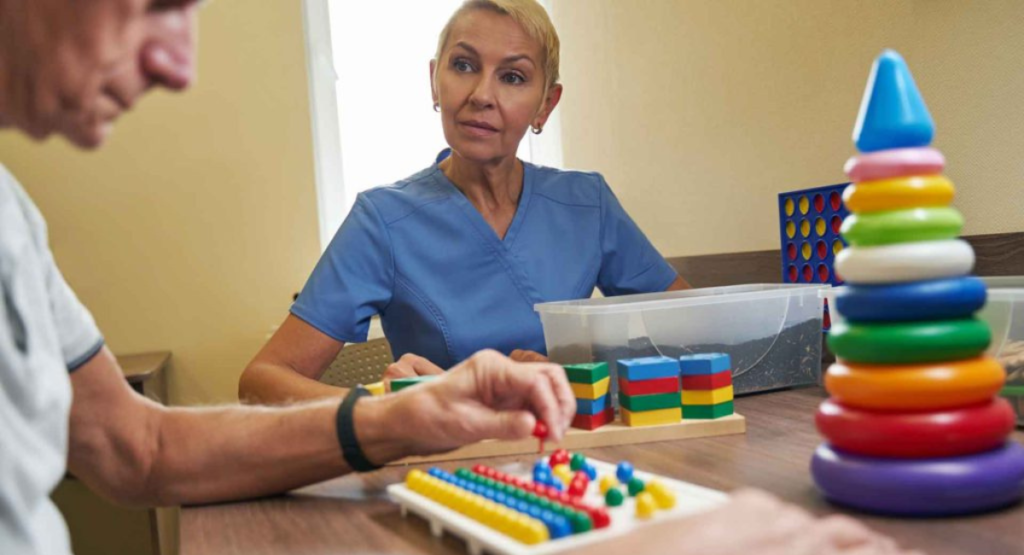A stroke can have far-reaching consequences, affecting not just physical health but also mental well-being and everyday functioning. For those who have had a stroke, the road to recovery might appear intimidating. However, with the correct direction and support, many people find hope and make progress via occupational therapy. Occupational therapy for stroke patients is critical in regaining independence, relearning skills, and adjusting to new problems. In this tutorial, we’ll go over the ins and outs of occupational therapy for stroke patients, providing suggestions, advice, and encouragement along the way.
Understanding the Impact of Stroke
Before diving into occupational therapy techniques, it’s important to understand what a stroke is and how it impacts people. An ischemic stroke and a hemorrhagic stroke are both forms of brain blockages that can interrupt blood flow to the brain. This interruption deprives the brain of oxygen and nutrients, resulting in fast cell death. The consequences might vary greatly depending on the degree and location of the stroke, ranging from moderate weakness or numbness to substantial paralysis or cognitive damage.
The Role of Occupational Therapy for Stroke Patients
Occupational therapy is a comprehensive approach to rehabilitation that focuses on restoring persons’ independence in daily tasks, or “occupations.” For stroke patients, this may entail relearning fundamental self-care skills like dressing, bathing, and eating, as well as more sophisticated activities like cooking, driving, and returning to work or hobbies. Occupational therapists collaborate with patients to assess their skills, establish objectives, and create individualized treatment programs based on their specific requirements and circumstances.
Early Intervention
Early intervention is a critical component of successful stroke therapy. The sooner occupational therapy begins after a stroke, the greater the possibility of recovery and functional improvement. During the acute period, therapists concentrate on stabilizing medical problems, minimizing complications, and introducing fundamental motions and exercises to preserve range of motion and prevent muscular contractures. As the patient advances through the subacute and chronic phases of recovery, therapy becomes more rigorous and goal-oriented, focusing on specific functional abilities and addressing any remaining problems or limits.
Building Strength and Mobility
Stroke survivors frequently experience physical deficits such as weakness, stiffness, and reduced range of motion. Occupational therapists use a number of approaches and exercises to treat these difficulties while increasing general strength and mobility. This may involve therapeutic exercises that target particular muscle groups, functional activities that practice everyday motions, and the use of assistive devices or adapted equipment to promote independence and safety.
Cognitive Rehabilitation
In addition to physical limitations, many stroke survivors suffer from cognitive problems such as memory loss, concentration deficiencies, and trouble problem-solving and making decisions. Occupational therapy includes cognitive rehabilitation procedures designed to improve cognitive performance and promote brain health. Memory exercises, attention training assignments, problem-solving activities, and the application of compensatory methods may all be used to assist persons in adapting to their cognitive problems and increasing their independence in everyday life.
Emotional Support
Recovering after a stroke is both a physical and emotional challenge. Many stroke survivors experience feelings of frustration, despair, anxiety, and loss as they negotiate the hurdles of recovery and adjust to life following the stroke. Occupational therapists play an important role in offering emotional support, encouragement, and coping skills to patients who are dealing with challenging emotions and want to be optimistic about their rehabilitation.
Residential Adjustments and Ecological Changes
Returning home after a stroke can bring new challenges and hurdles for patients and their families. Occupational therapists analyze the home environment and propose changes and adjustments to improve safety, accessibility, and independence. This may include putting grab bars in the bathroom, reducing tripping hazards, changing furniture to improve mobility, and introducing assistive gadgets or adapted technologies to help with everyday tasks and enhance confidence and autonomy.
Community Reintegration: Bridge the Gap to Life After Stroke
As stroke patients advance through their rehabilitation, occupational therapy focuses on community reintegration and involvement in meaningful activities and tasks, rather than just the clinic or hospital settings. Occupational therapists help patients determine their objectives and interests, investigate options for social engagement and recreation, and devise techniques to overcome barriers to involvement in employment, leisure, and social activities. Occupational therapy helps stroke patients survive outside of their diagnosis by allowing them to reclaim their lives and follow their hobbies.
Conclusion
In conclusion, occupational therapy is an essential component of stroke rehabilitation, providing patients with hope, support, and direction as they traverse the hurdles of recovery and reconstruct their lives. Occupational therapists have a varied role in allowing stroke patients to reach their objectives and live life to the fullest by treating physical limitations and cognitive changes, as well as providing emotional support and promoting community reintegration. Individuals who embrace the ideas of early intervention, tailored treatment, and holistic rehabilitation may begin on a recovery journey with confidence, resilience, and drive.
We are India’s first comprehensive continuum care provider. We provide multidisciplinary out of hospital care to acute and post-acute and chronically ill patients at our critical care facilities and your home.


